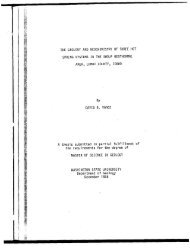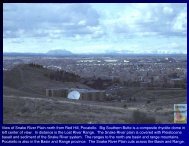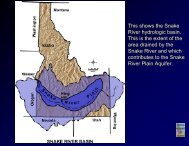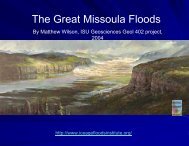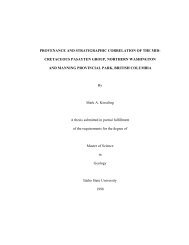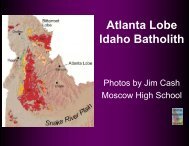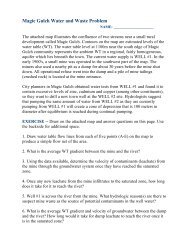Bonneville Flood
Bonneville Flood
Bonneville Flood
You also want an ePaper? Increase the reach of your titles
YUMPU automatically turns print PDFs into web optimized ePapers that Google loves.
Mule, near Brigham City, Utah. View looks east toward the front of the Wasatch Range<br />
near Perry, Utah. Note fruit trees of Utah’s Fruit Way on the lower slopes. The<br />
<strong>Bonneville</strong> Shoreline is the highest flat surface and the Provo shoreline is about 400 feet<br />
below that. Recessional shorelines are successively lower on the hill. The mule would<br />
have been about 900 feet under water at the height of Lake <strong>Bonneville</strong>.
View of Red Rock Pass from the north. Oxford Peak is to the south, and Cache Valley east of it. At the time of<br />
Lake <strong>Bonneville</strong>, the benches on the west side of Cache Valley extended across and met the benches coming south<br />
from the Portneuf Range. The red rocks of the Pass were buried by gravel. The area on the west side of the view<br />
is a post flood landslide. The area of shaded uneven topography on the east side of the view is jumbled blocks of<br />
Cambrian limestone. The headwaters of March Creek, in shade on the east side of the view, make a 180 degree<br />
turn and head north into the Portneuf and Snake River. Formerly they flowed south to Cache Valley.
Red Rock Butte at Red Rock Pass. The butte is made of Cambrian limestone. The dam level<br />
was near the top of the butte.
Alcove in basalt flow south of Inkom Idaho that was cut as a dry waterfall in the Lake<br />
<strong>Bonneville</strong> <strong>Flood</strong>. Marsh Creek in distance, below the basalt flow. Native American sites<br />
are located in this sheltered alcove.
Basalt flow near Inkom, scoured by flood. This is an example of scabland topography
View east of Portneuf Narrows southeast of Pocatello. This is the Gateway to the Pacific<br />
Northwest. The basalt of Portneuf Valley came through here 500,000 years ago, the Lake<br />
<strong>Bonneville</strong> <strong>Flood</strong> 14,500 years ago, and the Utah Northern narrow gauge railroad first in 1878.<br />
The Lake <strong>Bonneville</strong> flood here was 400 feet deep to the top of the lowest bench on the left<br />
(north) side of the gap.
View looking north to Pocatello Idaho, May 1983. Note high water table in gravel pit.
<strong>Flood</strong> Hydrograph for the Portneuf River at Pocatello. Note the large floods of<br />
1963 and 1962.
Size (in feet)<br />
of <strong>Bonneville</strong><br />
<strong>Flood</strong><br />
Boulders in<br />
the Pocatello<br />
area. The<br />
floodwaters<br />
slowed down<br />
and dropped<br />
boulders of<br />
decreasing<br />
sizes the<br />
farther north<br />
they went.
Boulders being dug at Simplot Square, downtown Pocatello. These boulders were moved by<br />
the Lake <strong>Bonneville</strong> <strong>Flood</strong>.
Lake Channel, cut by the Lake <strong>Bonneville</strong> <strong>Flood</strong> northwest of American Falls Reservoir.
<strong>Bonneville</strong> <strong>Flood</strong> path along the Snake River at Murtaugh Bridge, east of Twin Falls. The<br />
flood filled the canyon of the Snake River up to the trim line where there is not enough soil to<br />
grow crops. Note the Boulder and Gravel Bar that is mined for road material in the right<br />
center of the picture. This is a Lake <strong>Bonneville</strong> <strong>Flood</strong> gravel.
Shoshone Falls, deepened by the Lake <strong>Bonneville</strong> <strong>Flood</strong>, north of Twin Falls, Idaho.
Petrified Watermelons are Lake <strong>Bonneville</strong> <strong>Flood</strong> Boulders. This sign, near Bliss, Idaho, was<br />
constructed by Fearless Ferris, who owned the Stinker Station gasoline chain.



